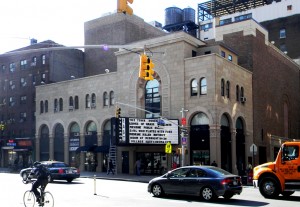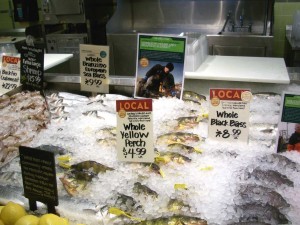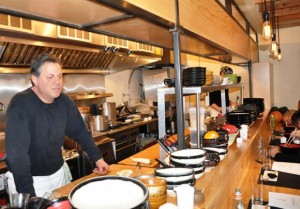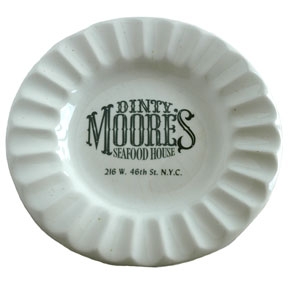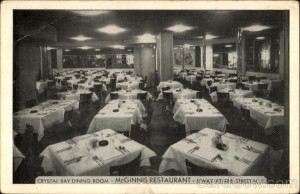The best potato dish ever devised by humankind is pommes souflee. These airy, crisp bits of spud heaven are a testament to culinary creativity. The method of preparation is a double frying of potatoes and requires efficient temperature control and deft hands. As mentioned in a previous post, HG always enjoyed them at the old Oak Room in New York’s Plaza Hotel. In London, HG consumed them accompanying a toothsome mixed grill in the restaurant of the Connaught Hotel ( In its heyday, despite its English location, it was hailed as the best French restaurant in the world). However, the best pommes souflee were found at the long closed, aptly named Charles a la Pommes Souflee on New York’s E. 55th Street. Second helpings were encouraged. HG took advantage. Sadly, pommes souflee have virtually disappeared from New York, Paris and London menus. There is one place to taste them in all their glory. This means a voyage to Paris and a visit to Au Boeuf Couronne, a venerable steak house in Paris 19e. Order a saignant (rare) steak topped with either sauce bearnaise or beef marrow. A big side of the lush taters. Clog your arteries with pleasure.
Spud Heaven
March 31st, 2014 § 0 comments § permalink
Wise Words
March 29th, 2014 § 0 comments § permalink
From HG (an old guy), here are some wise words that may help meet the adversities of old age: One. HEALTH. Joan Erikson, noted psychologist and wife of famed psychologist and author Eric Erikson, wrote (when she was in her 80’s): “When you get older, even the simple activities of daily living may present difficulty. One must adapt. With whatever tact and wisdom we can muster, disabilities must be accepted with lightness and humor.” Two. BE SENSIBLE. Damon Runyon paraphrased Ecclesiastes thusly: “The race is not always to the swift, nor the battle to the strong, but that’s how the smart money bets.” Three. GRASP PLEASURE. Heed the Italian advice: “Life is short and brutish. The end is painful. So, in the meantime, let’s have a good meal.”
Cafe Royale
March 28th, 2014 § 0 comments § permalink
The Cafe Royale, ah, the Cafe Royale!! Few people (and they are few, mainly men and women in their 90’s) who can say those words without a warm smile. The Cafe Royale had a long run: 1908-1952. It was located in New York on the corner of Second Avenue and E.12th (now a movie theater). For much of the cafe’s history, Second Avenue was the home of the Yiddish theater. There were numerous theaters and vaudeville venues. Stars galore: Jacob Ben Ami; Jacob and Celia Adler (their relations included Luther and Stella); Maurice Schwartz; Molly Picon; Menasha Skolnick. Aaron Lebedoff, Leo Fuchs and Moishe Oysher were vaudeville luminaries. Munii Weisenfreund (he changed his name to Paul Muni) and Walter Matthau were among the many actors who left the Yiddish theater to attain fame on Broadway and in Hollywood. HG only visited Cafe Royale in its final year — 1952. It was a sad place then, inhabited by old Yiddish actors bewailing (over numerous cups of tea) the death of a once vigorous theater. In its heyday, the Cafe Royale was the Yiddish Sardi’s—a schnapps and schmaltz fueled joint that teemed with Yiddish-speaking performers, composers, producers, set designers, musicians, press agents, dancers, playwrights—plus ardent fans and hangers on. It was one big Yiddish schmooze-fest and kibbitz. According to HG’s older friends, the Cafe Royale was the scene of theatrical feuds, naughty romance and artistic argument. The food and drink were savory. Voices were loud. Waiters were irascible. Hy Kraft, screenwriter and playwright, wrote a play about Cafe Royale, Cafe Crown. It opened on Broadway in 1942. Directed by Elia Kazan, it had a four month run. Kazan didn’t think much of Kraft as a playwright but said “He had a talent for the Jewish anecdote.” And, the play is as stuffed with Jewish jokes and anecdotes as an old Cafe Royale patron sitting back after a meal of chopped liver and Hungarian goulash. Joe Papp of New York’s Public Theater was fond of the Cafe Royale, the Yiddish theater and Cafe Crown. He revived the play in 1988 in a production starring Eli Wallach. Cafe Crown had another life in 1964. Kraft adapted it as a musical and HG/BSK went to the opening night. HG/BSK were pals with theater folks close to Kraft. The musical was not a success but it introduced a very engaging young actor, Alan Alda. HG/BSK joined Alda and his wife at Sardi’s for a post-theater dinner and found him to be a modest and amusing young man, surprising in someone whose star quality was so evident. Hy Kraft (he wrote it with Johnny Mercer) had a big hit in the Broadway musical (later a movie) Top Banana. It made Phil Silvers a star. Hy Kraft was an indomitable liberal. He defied the Red hunters and was blacklisted in Hollywood. Later, he battled against the American presence in Vietnam. The tragedy of his life was the early death of his daughter, Jill, a lovely and talented ingenue.
Puzzling Fish Logistics
March 26th, 2014 § 0 comments § permalink
The historic, architecturally unique city of Santa Fe, just a few miles from HG/BSK’s home, is far from any ocean. And, far from any lake. So, HG is puzzled. Why is fish (from Whole Foods or Kaune’s Grocery) so good and so fresh ? HG thought about this as HG gave a pound of never frozen Pacific sole a quick saute in a blazingly hot pan. One of HG’s talents (they are very few) is sauteing fish. These filets (dipped in beaten egg and rolled in Zatarain’s fish fry mix) were superb. Accompanied by spring asparagus dripping golden melted butter, HG/BSK drank a bottle of chilled Muscadet and smiled happily between swallows. And, a few nights before, HG/BSK knocked off a thick, fresh swordfish steak. BSK cut the fish into small chunks and gave them a quick stir fry in olive oil and garlic (fish was seared but the interior was rare). BSK added the swordfish to a puttanesca sauce (black olives, tomatoes, anchovies, capers). Al dente linguine was added to the pan to absorb the sauce. Showered with chopped Italian parsley, this was southern Italian cooking at its best. So, what’s the secret? Are there special jets bringing these good things to The City Different?
Secret of A Good Paris Steak: Imported Meat
March 25th, 2014 § 0 comments § permalink
When HG wanted to get some vigorous jaw exercise in Paris, HG ordered a bavette (flank steak) or an onglet (hangar or butcher steak). Tough? These were broiled baseball mitts. Well, it seems times are changing and the outlook is rosy (or bleu or saignant) for the Paris steak eater. The French, supremely nationalistic about their cuisine, are finally making an admission: French beef can be admirable when long cooked as pot au feu or boeuf bourgignon. But, served as steak French beef is usually tough and tasteless when compared to imports from Germany, Scotland, Argentina and the United States. That’s why more than 20% of meat presently served in French restaurants is imported. And, that number is rising. Good Paris steakhouses like Le Severo and Au Boeuf Couronne now depend on imports. You can get a nice steak at those places (Severo’s frites are exemplary and Boeuf Couronne serves hard-to-find pommes souflee). But, if you want really great steak nothing beats a traditional New York eatery like Spark’s and Keen’s Chop House (yes, Peter Luger’s is good but a tad overrated). HG believes New York’s restaurateurs reserve the best cuts in the world for themselves.
Sad News (and Some Consolations)
March 24th, 2014 § 0 comments § permalink
Shibumi Ramenya, the delightful ramen and izakaya restaurant, has closed. The uncompromising chef Eric Stapelman is moving the operation from Santa Fe to Seattle. HG will miss the tonkatsu pork ramen and the cod fritters. HG thinks Seattle will enjoy Stapelman, a true original, and his cuisine. There is some consolation for Santa Fe lovers of Japanese cuisine. Izanami, a new restaurant, has opened at the beautiful Ten Thousand Waves resort. Have not sampled the food yet but the menu (no sushi but a variety of izakaya type dishes) is appealing. HG’s standby, Shohko Cafe, continues to serve scintillating tempura, eel and soba. The age tofu, a miracle of crispness and succulence, is the best HG has ever tasted. Talin, the international grocer, has a ramen bar. But, real excellence is provided by a Chinese pop-up there. Open only on Monday, a Chinese family serves great dumplings and a huge bowl of dan dan noodles (this is really a tasty combo of traditional dan dan with mopu tofu). Ask for the milder condiments. The hot ones are numbing. HG will have to wait until April to taste ultimate Japanese cuisine. That’s when SJ, Exquisite Maiko, handsome Haru and adorable Teru arrive for a New Mexico visit. With EM in the kitchen, miraculous gyoza, curry and ethereal fish dishes are in HG’s gourmandizing future.
Stick-To-The-Ribs Eating
March 22nd, 2014 § 0 comments § permalink
Yes, that was the descriptive phrase for heavy, high-cal, stratospheric cholesterol, cheap food devoured by HG in New York during his college days. A real belly buster was mofongo, found in Puerto Rican restaurants in East Harlem, South Bronx and Broadway in the 140’s. Mofongo consisted of mashed, fried plantains (green bananas) formed into a big dumpling shape and served in a bowl of broth with garlic, olive oil and cuchifritos (pork cracklings). HG also ate big bowls of thick skinned potato pierogi with sour cream in Polish restaurants on lower First Avenue and giant plates of ground pork stuffed cabbage at Ukrainian restaurants in the same neighborhood. In African-American Harlem, HG feasted on fried catfish and ribs with mac-and-cheese, gravy doused rice and greens enriched by ham hocks. In the Mott Haven neighborhood of The Bronx, Mom-and-Pop Italian restaurants served bowls of spaghetti with oil and garlic of a size designed to appease the appetite of guys who worked all days with their hands and strong backs. Prices for these aforementioned treats ranged from 75 cents to $1.75.
Dinty Moore’s: Irish/Jewish and All Good
March 19th, 2014 § 4 comments § permalink
St, Patrick’s Day has come and gone and tons of nasty corned beef and cabbage have been consumed. Irish bacon and greens was the traditional holiday dish in Ireland. This got converted to corned beef and cabbage in the United States (HG doesn’t know when). Anyway, today’s inebriated Paddy’s Day revelers eat stringy corned beef (injected with lots of chemical tenderizer), limp cabbage and sadly overdone boiled potatoes. HG’s late Mom would comment: “Feh!!”. There was a time when corned beef and cabbage was a gourmand dish and it was served at Dinty Moore’s, an Irish restaurant on W. 46th Street in New York’s theater district. James “Dinty” Moore opened the restaurant in the 1920’s. Closed in the early 70’s. If Lindy’s and the Stork Club were identified with Walter Winchell, the powerful columnist and radio personality, Dinty Moore’s was identified with Louis Sobol of the Journal-American, the kindest and gentlest of the Broadway columnists. James Moore was the favorite restaurateur of the theatrical and sporting gentry because he defied Prohibition. He ignored it. It was always business as usual at Dinty Moore’s. Moore was often hauled into court but he paid his fines with a smile and kept serving good strong spirits. As the years rolled by, Moore recognized the fact that many of his customers were Jewish. He added gefilte fish (much better than HG’s Mom’s version) to the menu and the Irish lamb stew, beef stew and liver and onions were always made with kosher products. (The rasher of bacon that accompanied the liver and onions was decidedly non-kosher). Prices were high but were paid uncomplainingly because everything served was of the highest quality, plainly cooked and not disguised by intricate sauces. The signature dessert was rice pudding. It was sublime. It was a favorite of Jimmy Cannon, the eloquent sports columnist. A number of generations have grown up seeing Dinty Moore’s Beef Stew on supermarket shelves. No connection with the restaurant and HG doubts if it tastes anything like the wonderful New York food HG consumed at Dinty’s.
The Roast Beef Sandwiches Of Yesteryear
March 18th, 2014 § 1 comment § permalink
For many years the McGinnis Restaurant on New York’s Broadway (there was also a branch in the Sheepshead Bay neighborhood of Brooklyn) dispensed a lavish, rare roast beef sandwich. Its rival was The Brass Rail on nearby Seventh Avenue. The Brass Rail was adjacent to the Roxy movie palace (named after the showman “Roxy” Rothafel and demolished to make way for undistinguished office towers). The Brass Rail specialty was “The French Dip”. This was a roast beef sandwich on a mini-baguette dipped in a savory beef gravy. (Messy. But not as messy as the Chicago Beef Sandwich, a favorite in the Windy City). The best of all New York City roast beef sandwiches was served at Shine’s on 7th Avenue between 33rd and 34th Streets near Penn Station. There a stately African-American man in a chef’s hat carved slices behind a counter from a vast roast with surgical precision. On the more pedestrian side, HG liked the roast beef sandwiches served at many of New York’s old fashioned Jewish delicatessens in Brooklyn and the Lower East Side. A nice smear of chicken fat on seeded rye. Roast beef. Coarse salt. Black pepper. Sliced sweet onion. In the days when Harlem was a Jewish neighborhood, there was a Harlem delicatessen (name, alas, forgotten) that served the sandwich and attracted customers who had to patiently wait in a long line in order to enjoy the treat. The Chicago Beef and the Philadelphia Cheese Steak never caught on in New York. The New York attitude: “Why hide the flavors of delicious rare roast beef carved from a prime rib, corned beef, pastrami and brisket?” Why, indeed? HG/BSK had a delightful Saturday tradition after shopping at Bloomingdale’s.. HG/BSK would visit nearby Dover Delicatessen and pick up roast beef, ripe Liederkranz cheese, a sliced rye bread, potato salad, cole slaw. HG/BSK liked their roast beef sandwiches with Russian dressing. The cheese was showered with chopped onions and paprika. Much fun.
When The Great White Way Was Appetizing
March 17th, 2014 § 0 comments § permalink
There is a glittery expanse of Montparnasse in Paris that is filled with movie houses, creperies and four landmark restaurants. The super-pricey (and worth it) Le Dome which serves the best grilled sole in Paris (the fish swims in sublime lemony melted butter). La Rotonde which has fine oysters and steak tartare. Select (nice for a pre-dinner drink). La Coupole (beautiful art deco decor and fine oysters but everything else is miserable in this chain-operated trap for tourists). Montparnasse reminds HG of New York’s Broadway in its glory days (which ended in the 60’s). There were the big time movie houses: Paramount (where Frank Sinatra thrilled the bobby soxers); Capitol, Strand (all with stage shows in addition to first run movies)). Also Criterion, Trans-Lux, Palace, etc. Loads of good restaurants (mass and class) starting at 42nd Street and moving north into the 50’s where they gave way to auto showrooms. Here were some of them: Hector’s Cafeteria (good, cheap food); Rosoff’s (excellent roast duck); Turf (fine cheesecake); McGinnis’ (lavish roast beef sandwiches plus sea food specialties); Jack Dempsey’s (The champ served fine steaks). Just a few steps oiff Broadway was Gluckstern’s, a top flight Jewish kosher restaurant (not to be confused with the OTHER Gluckstern’s that was on Delancey St.). Also just off Broadway was Dinty Moore’s (best corned beef and cabbage plus liver with onions and bacon). The unquestioned essential Broadway restaurant was Lindy’s. Immortalized in Damon Runyon’s fiction. Comedians like Milton Berle, Jack E.Leonard, Jack Carter and Henny Youngman topped each other with one liners in its environs. It was where the powerful columnist Walter Winchell lunched. Song writers, bookmakers, gamblers, press agents, actors, producers, musicians and other colorful folk filled the tables. The food, which ranged from Jewish-American specialties to superb pork sausages with eggs, was splendid. And, the cheesecake was legendary (even better than Junior’s or Turf). What happened to the wonderful New York cuisine that Lindy’s exemplified? Gone. The world changes and not always for the better.

